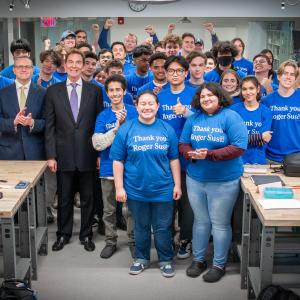Alumnus spurs research and innovation at CWRU
Roger Susi has always been a tinkerer. The Pennsylvania native began taking apart electronics—and “sometimes putting them back together”—as early as 6 years old.
He was already a sophomore studying pre-med at the University of Mount Union in Alliance, Ohio, when he heard about Case Western Reserve University’s nascent biomedical engineering program. He leapt at the opportunity to combine his two passions and transferred to CWRU, graduating in 1977.
Today, Susi is the founder of two prominent medical technology startups: InVivo Research Inc., which launched the world’s first successful MRI patient vital signs monitoring device and, more recently, Iradimed, known for its MRI infusion pump.
The alumnus has used his Case Western Reserve education to help others and now is using his success in business to enable the university to expand its research enterprise.
Susi and his wife, Kayoko, committed $25 million for CWRU’s upcoming Interdisciplinary Science and Engineering Building (ISEB) on Case Quad. The impact of their gift—the largest for the project to date—will be doubled through a century bond.
“The No. 1 strength I gained [at CWRU] was learning how to think—how to solve problems quickly and with minimal cost and bother,” Susi said. “I have used those skills on a daily basis throughout my career, and that’s why I am giving back.”
When he first heard about the ISEB, Susi thought the project, while ambitious, was critical to the university's short- and long-term success.
“It’s competitive out there,” he said. “It’s important we attract the best minds to the university so it can grow. You need to invest in the physical space where they will work and come up with ideas.”
Susi is most excited to see the innovations and inventions that will come from the ISEB—technology that will help solve some of society’s greatest problems.
“Engineering is about making things that add value,” he said, noting his penchant for thinking from a business perspective. “I hope the licensed intellectual property that will be produced by these researchers will not only do good in the world, but also help make the university more financially sustainable in the long run.”
‘More than just a building’
While various projects across engineering and science disciplines will be worked on within the ISEB, one area in particular has caught Susi’s attention: neuroprosthetics.
Featured last year on the CBS News program 60 Minutes, the groundbreaking research led by CWRU faculty members Dustin Tyler and A. Bolu Ajiboye is bringing a renewed sense of touch to amputees and people with paralysis.
“That research is near and dear to me,” Susi said. “It’s the kind of work that will make the ISEB more than just a building. It will be a place where really great ideas are nurtured and things are discovered. That’s the good stuff.”
Susi understands the value of providing faculty members and students resources and freedom to experiment.
In 2019, he gave $2 million to establish the Roger E. Susi First-Year Engineering Experience—complete with a decked-out lab space, student lounge and introductory engineering course—and later endowed a professorship position to lead the program.
“Lectures are, of course, important, but it’s critical for students to get hands-on experience early,” Susi said. “I want them to have the opportunity to start making stuff, along with smoke, sparks and burning their fingers. Those are the experiences that stick with you.”
The signature course of the program takes students out of the classroom and into the Susi lab. Working with instructors, students conduct team projects with a focus on data analysis and programming, and learn how to use equipment in the Larry Sears and Sally Zlotnick Sears think[box].
“It can be frustrating for students to just sit in a lecture hall or solve prescriptive problems. This program helps them develop foundational skills that grow their confidence, and allows students to be part of the engineering community from day one,” said Director Kurt Rhoads, PhD, the Roger E. Susi Associate Professor, Division of Engineering Leadership and Professional Practice. “Roger’s support makes the program sustainable. We don’t have to worry about it going away—there will always be someone in my position to champion our students.”
Originally published in the summer 2024 issue of Forward Thinking magazine


